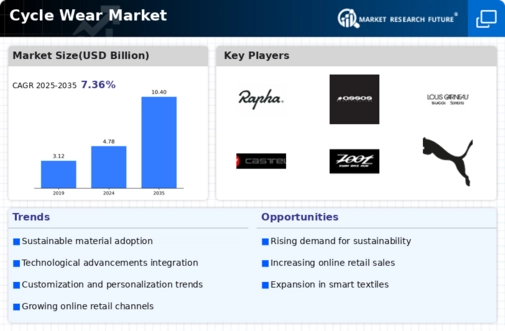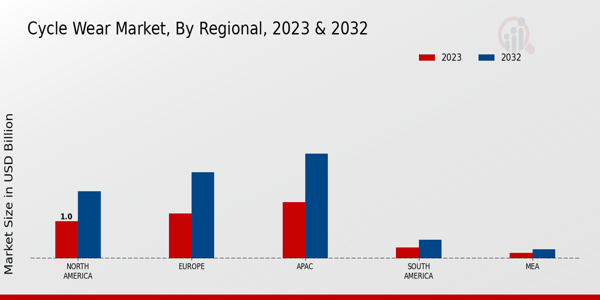Market Growth Projections
The Global Cycle Wear Market Industry is poised for substantial growth, with projections indicating a market value of 4.78 USD Billion in 2024 and an anticipated increase to 10.4 USD Billion by 2035. This growth trajectory suggests a compound annual growth rate of 7.36% from 2025 to 2035, reflecting a robust demand for cycling apparel. The expansion of the market is likely influenced by various factors, including health consciousness, sustainability trends, and technological advancements in fabric. These dynamics collectively contribute to a favorable outlook for the industry.
Sustainable Fashion Trends
Sustainability is becoming a pivotal factor in consumer purchasing decisions, particularly in the Global Cycle Wear Market Industry. As environmental concerns gain traction, brands are increasingly adopting eco-friendly materials and production processes. This shift not only caters to the ethical considerations of consumers but also aligns with the broader trend of sustainable fashion. The market is expected to reach 10.4 USD Billion by 2035, indicating a robust growth trajectory. Companies that prioritize sustainability may attract a loyal customer base, further driving market expansion.
Rising Health Consciousness
The increasing awareness of health and fitness among consumers appears to be a primary driver for the Global Cycle Wear Market Industry. As individuals seek to incorporate physical activity into their daily routines, cycling emerges as a popular choice. This trend is evidenced by the projected market value of 4.78 USD Billion in 2024, reflecting a growing demand for specialized cycle wear that enhances performance and comfort. The emphasis on health and wellness is likely to continue influencing consumer preferences, thereby propelling the market forward.
Growing Popularity of Cycling Events
The rising participation in cycling events and competitions is a notable driver for the Global Cycle Wear Market Industry. Events such as marathons, triathlons, and cycling tours attract enthusiasts and professionals alike, creating a demand for specialized apparel. This trend is supported by the projected compound annual growth rate of 7.36% from 2025 to 2035, suggesting a sustained interest in cycling as a competitive sport. As more individuals engage in these events, the need for high-quality cycle wear becomes increasingly apparent, further stimulating market growth.
Technological Advancements in Fabric
Innovations in fabric technology are significantly influencing the Global Cycle Wear Market Industry. The introduction of moisture-wicking, breathable, and lightweight materials enhances the cycling experience, making it more comfortable and enjoyable. These advancements cater to both amateur and professional cyclists, who increasingly seek high-performance gear. As the market evolves, the integration of smart textiles may further revolutionize cycle wear, providing features such as temperature regulation and GPS tracking. This ongoing technological evolution is likely to sustain consumer interest and drive market growth.
Urbanization and Infrastructure Development
Urbanization and the development of cycling infrastructure are contributing to the growth of the Global Cycle Wear Market Industry. As cities invest in bike lanes and cycling-friendly facilities, more individuals are likely to adopt cycling as a mode of transportation. This trend not only promotes environmental sustainability but also encourages a healthier lifestyle. The increasing number of cyclists in urban areas creates a demand for appropriate cycle wear, which is expected to drive market expansion. The alignment of urban planning with cycling initiatives may further enhance this growth trajectory.

























Leave a Comment